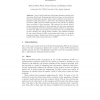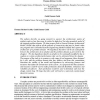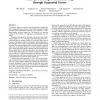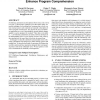160 search results - page 14 / 32 » The Evolution of Concurrent Control Software Using Genetic P... |
AE
2005
Springer
14 years 2 months ago
2005
Springer
Most of the Evolutionary Algorithms handling variable-sized structures, like Genetic Programming, tend to produce too long solutions and the recombination operator used is often co...
ECIS
2001
13 years 10 months ago
2001
The authors describe on going research to uncover the architectonic nature of artefacts and see how these may be related to high-level, but also grounded, model of the original pr...
ASPLOS
2011
ACM
13 years 5 days ago
2011
ACM
Concurrency bugs are caused by non-deterministic interleavings between shared memory accesses. Their effects propagate through data and control dependences until they cause softwa...
ICSE
2008
IEEE-ACM
14 years 9 months ago
2008
IEEE-ACM
Test-driven software development tackles the problem of operationally defining the features to be implemented by means of test cases. This approach was recently ported to the earl...
MSR
2006
ACM
14 years 2 months ago
2006
ACM
Evolutionary annotations are descriptions of how source code evolves over time. Typical source comments, given their static nature, are usually inadequate for describing how a pro...




